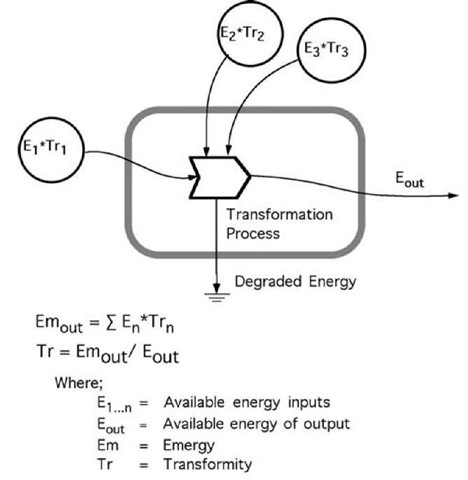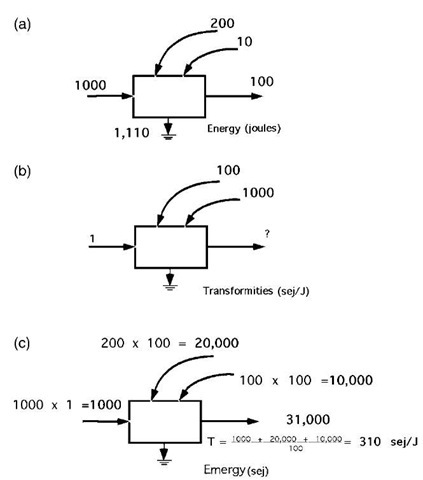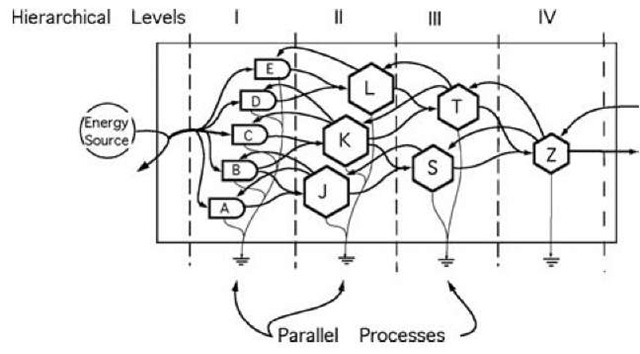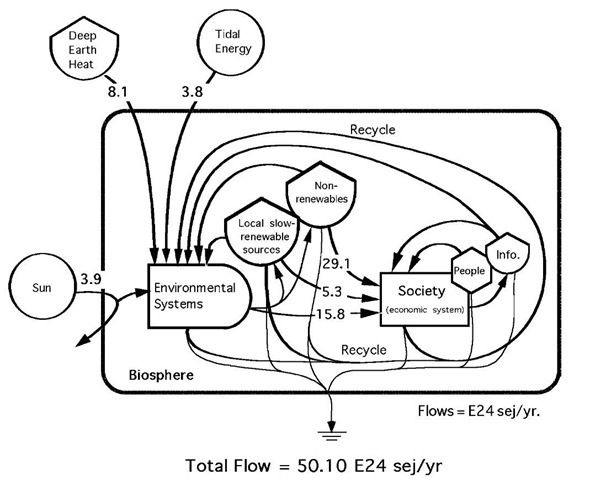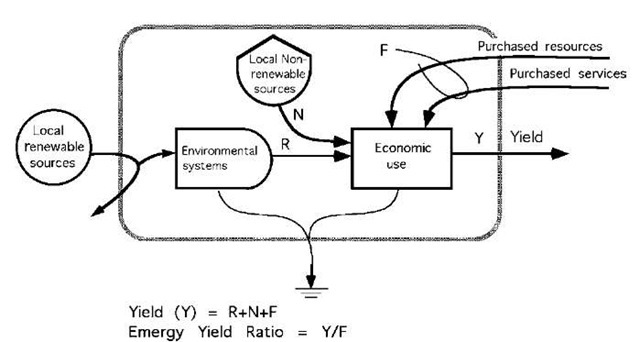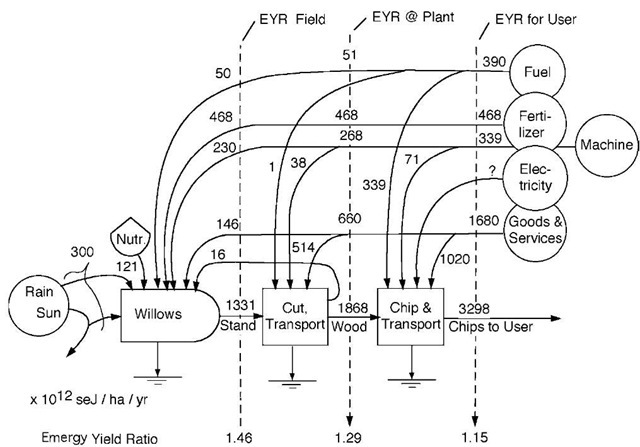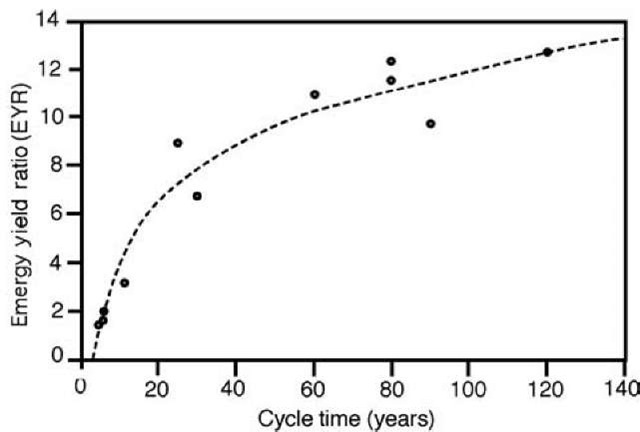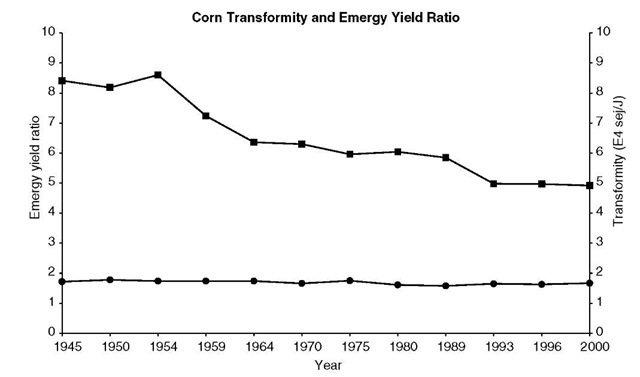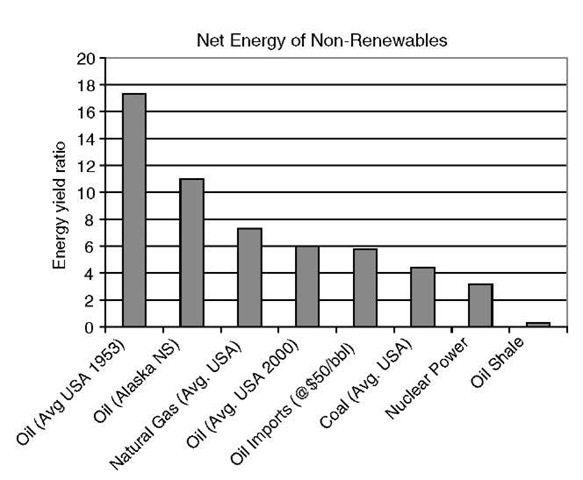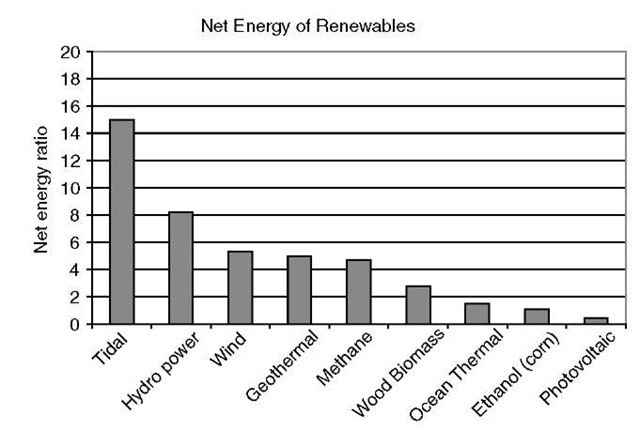Abstract
In this chapter, we briefly review H.T. Odum’s concepts and principles of emergy and related quantities.’1-5-1 The concept of energy quality is introduced and defined by transformity and specific emergy. Tables are given of data on global emergy flows, from which the emergy and transformities of most products and processes of the biosphere are calculated. Tables of transformity and specific emergy for many secondary products are provided. Finally, the concept of net emergy yield is introduced and defined using an Emergy Yield Ratio (EYR).
DEFINITIONS
Energy is sometimes referred to as the ability to do work. Energy is a property of all things that can be turned into heat and is measured in heat units (Btus, calories, or joules).
Emergy is the availability of energy [exergy (See the entry "Exergy" in this same topic.) For high-quality flows, such as fuels and electricity, the energy content and the available energy do not differ significantly. For this reason, the energy of a flow instead of its exergy is sometimes used for the sake of simplicity.] of one kind that is used up in transformations directly and indirectly to make a product or service. The unit of emergy is the emjoule, a unit referring to the available energy of one kind consumed in transformations. For example, sunlight, fuel, electricity, and human service can be put on a common basis by expressing them all in the emjoules of solar energy that are required to produce each. In this case, the value is a unit of solar emergy expressed in solar emjoules (abbreviated sej). Although other units have been used, such as coal emjoules or electrical emjoules, in most cases all emergy data are given in solar emjoules.
The emjoule, short for “emergy joule,” is the unit of measure of emergy. It is expressed in the units of the energy previously used to generate the product; the solar emergy of wood, for example, is expressed in the joules of solar energy that were required to produce the wood.
The emdollar (abbreviated em$) is a measure of the money that circulates in an economy as the result of some process. In practice, to obtain the emdollar value of an emergy flow or storage, the emergy is multiplied by the ratio of total emergy to the Gross National Product for the national economy.
Unit emergy values are calculated based on the emergy required to produce them. There are three types of unit emergy values, as follows:
Transformity is defined as the emergy per unit of available energy (exergy). For example, if 4000 solar emjoules are required to generate a joule of wood, the solar transformity of that wood is 4000 solar emjoules per joule (abbreviated sej/J). Solar energy is the largest, but most dispersed, energy input to the Earth. The solar transformity of the sunlight absorbed by the Earth is 1.0 by definition.
Specific emergy is the unit emergy value of matter defined as the emergy per mass, usually expressed as solar emergy per gram (abbreviated sej/g). Solids may be evaluated best with data on emergy per unit mass for its concentration. Because energy is required to concentrate materials, the unit emergy value of any substance increases with concentration. Elements and compounds not abundant in nature therefore have higher emergy/mass ratios when found in concentrated form, because more work was required to concentrate them, both spatially and chemically. Emergy per unit money is a unit emergy value used to convert money payments to emergy units. The amount of resources that money buys depends on the amount of emergy supporting the economy and the amount of money circulating. An average emergy/money ratio in solar emjoules per dollar can be calculated by dividing the total emergy use of a state or nation by its gross economic product. It varies by country and has been shown to decrease each year. This emergy/money ratio is useful for evaluating service inputs given in money units when an average wage rate is appropriate.
Empower is a flow of emergy (i.e., emergy per unit of time). Emergy flows are usually expressed in units of solar empower (solar emjoules per unit of time).
ENERGY, QUALITY, AND EMERGY
Probably the least understood and most criticized parts of H.T. Odum’s body of work[1-5] are his concepts and theories of energy quality, which are embodied in the 35 year development of the emergy concept. The development of emergy and its theoretical base cannot be separated from the development of the concept of energy quality. Beginning in the early 1970s, Odum suggested that different forms of energy have different capacities to do work. He reasoned that whereas energy is measured in units of heat (Btus, joules, calories), not all calories are the same when it comes to work processes, especially complex work processes. All energies can be converted to heat at 100% efficiency; thus, it is relatively easy and accurate to express energies in their heat equivalents.
Although heat-equivalent energy is a good measure of the ability to raise the temperature of water, it is not a good measure of more complex work processes. Processes outside the window defined by heat engine technology do not use energies that lend themselves to thermodynamic heat transfers. As a result, converting all energies of the biosphere to their heat equivalents reduces all work processes of the biosphere to heat engines. Human beings, then, become heat engines, and the value of their services and information is nothing more than a few thousand calories per day. Different forms of energy have different abilities to do work. A calorie of sunlight is not the same as a calorie of fossil fuel or a calorie of food unless it is being used to power a steam engine. A system organized to use concentrated energies like fossil fuels (or food) cannot process a more dilute energy form like sunlight, calorie for calorie. By the same token, a system organized to process dilute energy like sunlight (a plant, for instance) cannot process more concentrated energy like fossil fuels.
In this way, the use and transformation of energy sources is system dependent; the appropriateness of an energy source in a particular system is dictated by its form and is related to its concentration. The processes of the biosphere are infinitely varied and are more than just thermodynamic heat engines. As a result, the use of heat measures of energy that can recognize only one aspect of energy—its ability to raise the temperature of things—cannot quantify adequately the work potential of energies used in more complex processes of the biosphere. In the larger biosphere system as a whole, energies should be converted to units that span this greater realm, accounting for multiple levels of system processes, ranging from the smallest scale to the largest scales of the biosphere, and accounting for processes other than heat engine technology.
Fig. 1 In all processes, some energy is degraded and some is transformed into higher quality energy. The energy out is equal to the sum of the input energies minus the degraded energy. The emergy out is equal to the sum of the input emergies. The equations at the bottom of the figure show the general calculation of emergy of a product.
TRANSFORMITY AND SPECIFIC EMERGY
Transformity and specific emergy are unit emergy values calculated as the total amount of emergy required to make a product or service divided by the available energy of the product (resulting in a transformity) or divided by the mass of the product (resulting in a specific emergy). Figs. 1 and 2 illustrate the method of calculating a transformity, first in equation form (Fig. 1) and then with example numbers (Fig. 2). The transformity of the product is the emergy of the product divided by the energy of the product (in sej/J). If the output flow is in mass, the specific emergy of the product is the emergy of the output divided by the mass (in sej/g).
TRANSFORMITY AND QUALITY
Quality is a system property, which means that an “absolute” scale of quality cannot be made; neither can the usefulness of a measure of quality be assessed without first defining the structure and boundaries of the system. Self-organizing systems (be they the biosphere or a national economy) are organized with hierarchical levels (Fig. 3), and each level is composed of many parallel processes. This leads to two possible definitions of quality: parallel quality and cross quality. The first, parallel quality, is related to the efficiency of a process that produces a given flow of energy or matter within the same hierarchical level. (See Fig. 3 for an example of comparison among units in the same hierarchical level.) For any given output—say, electricity—there is almost an infinite number of ways to produce it, including all the generators, chemical processes, solar voltaic cells, and hydroelectric dams presently in service. A recent compilation of transformities for electricity from various production systems has yielded transformities from 6.23 X 104 sej/J, for a 2.5-MW wind generator, to 2.0 X 105 sej/J, for a 1280-MW oil-fired power plant in Italy.[6] A mean value of 1.66 X 105 sej/J from these and other plants was suggested by Odum for electricity when the source is assumed to come from “average” conditions.’4- The same rationale can be used for any energy or material flow as long as the flow is believed to represent the average. Each individual process has its own efficiency, and as a result, the output has a distinct transformity. Quality as measured by transformity in this case relates to the emergy required to make like products under differing conditions and processes. For the most part, transformities of like products are within the same order of magnitude.
Fig. 2 Method of calculating transformity. (a) energy flows; (b) transformity of the output is calculated by dividing the emergy of the output in c by the energy of the output in a.
Fig. 3 Complex systems are organized hierarchically where it takes many small components to support the next level in the hierarchy which in turn supports even fewer components at the next level, and so on. Comparison between components of the same level is a comparison of parallel quality while comparison of components from different levels is a comparison of cross quality.
The second definition of quality, cross quality, is related to the hierarchical organization of systems. In this case, transformity is used to compare components or outputs from different levels of the hierarchy, accounting for the convergence of emergy at higher and higher levels. (See Fig. 3 for an example of comparison of transformity between different hierarchical levels.) At higher levels, a larger convergence of inputs is required to support the component: many villages are necessary to support a city, many kilograms of grass to support a cow, etc. Also, higher feedback and control ability characterize components at higher hierarchical levels. Therefore, higher transformity, as equated with a higher level in the hierarchy, often means greater flexibility and is accompanied by greater spatial and temporal effects. In this definition of quality, the higher the transformity, the higher the quality of the process or product. Transformities of products from different hierarchical levels usually differ by at least one order of magnitude.
EMERGY OF THE GEOBIOSPHERE: THE BASIS FOR COMPUTING UNIT EMERGY VALUES
Annual Budget of Emergy Supporting the Geobiosphere
An emergy evaluation table of the main inputs to the geobiosphere of the Earth (omitting, for the moment, the emergy use from nonrenewable resources) is given in Table 1. The annual budget of emergy flow (empower) supporting the geobiosphere (the atmosphere, ocean, and Earth’s crust) includes solar energy, tidal energy, and heat energy from the deep Earth. These contributions to the geobiosphere total about 15.83 X 1024 sej/year.
Average Emergy Unit Values for Main Global Processes
Table 2 calculates unit emergy values for some main flows of the Earth. The total emergy input to the geobiosphere in solar emergy (15.83 X 1024 sej/year from Table 1) is divided by each global product’s ordinary measure (the number of joules or grams). The unit values that result are useful for other emergy evaluations for which global averages can be used.
Table 1 Annual emergy contributions to global processes
| Input Inflow (J/year) Emergy (sej/J) Empower X1024 (sej/year) | |||
| Solar insolationa | 3.93 X1024 | 1.0 | 3.93 |
| Deep earth heatb | 6.72 X1020 | 1.20 X104 | 8.06 |
| Tidal energy0 | 0.52X 1020 | 7.39!104 | 3.84 |
| Total | — | — | 15.83 |
Not including non-renewable resources. Abbreviations: sej, solar emjoules.
‘Sunlight: solar constant 2 gcal/cm /min = 2 Langley per minute; 70% absorbed; earth cross section facing sun 1.27 X10 m .
bHeat release by crustal radioactivity 1.98 X1020 J/year plus 4.74 X1020 J/year heat flowing up from the mantle Ref. 16. Solar transformity 1.2 X104 sej/J based on an emergy equation for crustal heat as the sum of emergy from earth heat, solar input to earth cycles, and tide Ref. 8.
cTidal contribution to oceanic geopotential flux is 0.52X1020 J/year Ref. 17. Solar transformity of 7.4X 104 sej/J is based on an emergy equation for oceanic geopotential as the sum of emergy from earth heat, solar input to the ocean, and tide following Refs. 8 and 18. Source: From University of Florida (see Ref. 7).
Temporary Emergy Inputs to the Geobiosphere
In the past two centuries, the production and consumption processes of human civilization that are using the large emergy in the geologic stores of fuels and minerals have reached a scale with global impact. Because these storages are being used much faster than they are being generated in geologic cycles, they are often called nonrenewable resources. They are actually very slowly renewed resources. Table 3 summarizes these additional components of the global emergy budget.
At present, the emergy from nonrenewable energy use that is contributed to the geobiosphere by human civilization is greater than the inputs from renewable sources. The result of this “temporary surge” of emergy is the accumulation of carbon dioxide in the atmosphere, adding to the greenhouse effects that may be altering ocean temperatures and, ultimately, the pattern and intensity of weather. The total renewable and nonrenewable emergy contributions to the global systems, including those released by humans, are 50.1 X 1024 sej/year. (Fig. 4).
UNIT EMERGY VALUES FOR FUELS AND SOME COMMON PRODUCTS
Unit emergy values result from emergy evaluations. Following are several tables of unit emergy values for some common materials and energy sources. In Table 4, unit emergy values are given for primary nonrenewable energy sources. In some cases, the unit emergy value is based on only one evaluation—plantation pine, for example. In other cases, several evaluations have been done of the same primary energy but from different sources, and presumably different technology, so unit emergy value is an average. Obviously, each primary energy source has a range of values depending on source and technology. Because they use data from typical production facilities (and actual operating facilities), the unit emergy values represent average conditions and can be used for evaluations when actual unit values are not known. If it is known that the conditions under which an evaluation is being conducted are quite different from the averages suggested here, detailed evaluations of the sources should be conducted.
Table 2 Emergy of products of the global energy system
| Product | Emergy” X1024 (sej/year) | Production | Emergy |
| Global latent heatb | 15.83 | 1.26 X1024 J/year | 12.6 sej/J |
| Global wind circulation0 | 15.83 | 6.45 X1021 J/year | 2.5 X103 sej/J |
| Global precipitation on landd | 15.83 | 1.09 X1020 g/year | 1.5 X 10s sej/g |
| Global precipitation on lande | 15.83 | 5.19 X1020 J/year | 3.1 X104 sej/J |
| Average river flowf | 15.83 | 3.96 X1019 g/year | 4.0 X 10s sej/g |
| Average river geopotential® | 15.83 | 3.4 X1020 J/year | 4.7 X104 sej/J |
| Average river chem. energy11 | 15.83 | 1.96 X1020 J/year | 8.1 X104 sej/J |
| Average waves at the shore1 | 15.83 | 3.1 X1020 J/year | 5.1 X104 sej/J |
| Average ocean currentj | 15.83 | 8.6 X1017 J/year | 1.8 X107 sej/J |
aMain empower of inputs to the geobiospheric system from Table 1 not including non-renewable consumption (fossil fuel and mineral use). bGlobal latent heat = latent heat of evapotranspiration 1020 mm/year, (1020 mm/year)(1000 g/m2/mm)(0.58 Cal/g)(4186 J/Cal)(5.1 X 1014m2) = 1.26X 1024 J/year.
cGlobal wind circulation, 0.4 watts/m2 Ref. 19 (0.4 J/m2/sec)(3.15 X 107 sec/year)(5.12 X1014 m2/earth) = 6.45X 1021 J/year. dGlobal precipitation on land= 1.09X1011 m3/year Ref. 20 (1.09X 1014 m3)(1 X 10s kg/m3) = 1.09 X1020 g/year.
Chemical potential energy of rain water relative to sea water salinity (1.09 X1020 g/year)(4.94 J Gibbs free energy/g) = 5.19 X1020 J/year. fGlobal runoff, 39.6X 103 km3/year (Todd 1970) (39.6X 1012 m3/year)(1 X 10s g/m3) = 3.96X 1019 g/year.
EAverage river geopotential work; average elevation of land = 875 m (39.6X 1012 m3/year)(1000 kg/m3)(9.8 m/sec2)(875 m) = 3.4X 1020 J/year. hChemical potential energy of river water relative to sea water salinity (3.96X 1019 g/year)(4.94 J Gibbs free energy/g) = 1.96X 1020 J/year. ‘Average wave energy reaching shores, Ref. 21 (1.68 X108 Cal/m/year)(4.39 X108 m shore front)(4186 J/Cal) = 3.1 X1020 J/year. 1 Average ocean current: 5 cm/sec Oort et al. 1989; 2 year turnover time (0.5)(1.37 X1021 kg water)(0.050 m/sec)(0.050 m/sec)/(2 year) = 8.56 X1017 J/year. Source: From University of Florida (see Ref. 7).
Table 3 Annual emergy contributions to global processes including use of resource reserves
Abbreviations: sej, solar emjoules; t, metric ton; oil eq., oil equivalents.
‘Values of solar emergy/unit from Ref. 4 and modified to reflect a global resource base of 15.83 X1024 sej/year. bRenewable Inputs: Total of solar, tidal, and deep heat empower inputs from Ref. 4.
cTotal oil production = 3.3 X109 t oil equivalent Ref. 8. Energy flux = (3.3 X109 t oil eq.)(4.186X1010 J/t oil eq.) = 1.38X 1020 J/year oil equivalent. dTotal natural gas production = 2.093 X109 m3 Ref. 8. Energy flux = (2.093 X1012 m3)(3.77 X107 J m3) = 7.89 X1019 J/year. “Total soft coal production = 1.224 X109 t/year Ref. 8. Total hard coal production = 3.297 X109 t/year Ref. 8. Energy flux = (1.224 X109 t/year)(13.9 X109 J/t) + (3.297 X109 t/year)(27.9 X109 J/t) = 1.09 X1020 J/year.
fTotal nuclear power production = 2.39X 1012kwh/year Ref. 8. Energy flux = (2.39X 1012 kwh/year)(3.6X 10sJ/kwh) = 8.6X 1018J/year electrical equivalent.
gAnnual net loss of forest area= 11.27 X 10s ha/year Ref. 23. Biomass=40 kg m2; 30% moisture Ref. 24. Energy flux = (11.27 X 10s ha/year)(1 X104 m2 /ha)(40kg m2)(1.3 X107 J/kg)(0.7) = 5.86X 1019 J/year.
hTotal soil erosion = 6.1 X 1010 t/year Refs. 25 and 26. Assume soil loss 10 t/ha/year and 6.1 X109 ha agricultural land = 6.1 X 1016/g/year (assume 1.0% organic matter), 5.4 Cal/g. Energy flux = (6.1 X1016 g)(0.01)(5.4 Cal/g)(4186 J/Cal) = 1.38X 1019 J/year.
‘Total global phosphate production = 137 X 10s t/year Ref. 27. Gibbs free energy of phosphate rock=3.48 X102 J/g. Energy flux = (137 X1012 g)(3.48 X102 J/g) = 4.77 X1016 J/year.
jTotal limestone production = 120 X 10s t/year Ref. 27. Gibbs free energy phosphate rock=611 J/g. Energy flux = (120X1012 g)(6.11 X 102 J/g) = 7.33 X1016 J/year.
kTotal global production of metals 1994: Al, Cu, Pb, Fe, Zn Ref. 28: 992.9 X 10s t/year = 992.9X 1012 g/year. Source: After Elsevier (see Ref. 30).
Table 5 lists the unit emergy values for some common products in order of their transformity. Only a few products are given in this table, but many more evaluations leading to unit emergy values have been conducted and are presented in a set of Emergy Folios published by the Center for Environmental Policy at the University of Florida.’7’8-
NET ENERGY AND EMERGY YIELD RATIO
The concept of net energy has played an important role in the development of energy quality and emergy. The concept of net production in ecosystems is widely used and understood as a measure of fitness of ecological systems. When applied to the human economy, the concept suggests that an energy source must be able to provide a net contribution to the economy of the larger system in which it is embedded (i.e., it must provide more energy than it costs in extraction and processing). Because this principle must be applicable to all living systems—from ATP-providing energy to the biochemical reactions in living systems, to photosynthesis, to the energy expended by animals as they graze or chase prey—it seems logical that it must also be applied to the processes of extracting fossil fuels from the Earth and to energy production of all sorts that drives economic sectors and human societies.
Fig. 4 Total emergy driving biosphere processes. For millions of years the driving emergy was dominated by the sources of sun, deep heat, and tidal momentum, now the dominant emergy flows are those associated with human society.
Table 4 Unit emergy values for primary non-renewable energy sources
| Item | Transformity | |
| sej/J | sej/g | |
| Plantation pine | 1.1 X 104 | 9.4!107 |
| (in situ) | ||
| Peat | 3.2X 104 | 6.7X 108 |
| Lignite | 6.2X 104 | |
| Coal | 6.7 X 104 | |
| Rainforest wood | 6.9 X 104 | 4.1 X 108 |
| (chipped, trans.) | ||
| Natural gas | 8.1 X 104 | |
| Crude oil | 9.1 X 104 | |
| Liquid motor fuel | 1.1X 10s | |
| Electricity | 3.4 X 10s |
Odum suggested, “The true value of energy to society is the net energy, which is that after the costs of getting and concentrating that energy are subtracted.”’9-
An Emergy Yield Ratio (EYR) is used to calculate the net contribution of energy sources to the economy. The EYR, as its name implies, is the ratio of the yield from a process (in emergy) to its costs (in emergy). The diagram in Fig. 5 illustrates the concept. The yield from this process is the sum of the input emergy from all sources: the environmental renewable source on the left (R), the nonrenewable storage (N), and the two purchased flows from the right (F). In the case of fossil fuels, there is little input from renewable sources, because the vast majority of the input comes from deep storages in the Earth. The EYR is the ratio of the yield (Y) to the costs (F) of retrieving it. The costs include energy, materials, and human service purchased from the economy, all expressed in emergy.
In practice, calculating the net energy of a process is far more complex than is shown in Fig. 5. Most processes, especially energy technologies, have many stages (or unit processes) and many inputs at each stage. As an example, Fig. 6 illustrates a series of processes beginning with an “energy crop”—fast-growing willow—and ending with wood chips that will be used in an electric power plant. At each stage in the process, an EYR can be calculated.
Table 5 Unit emergy values for some common products
| Transformity | Specific | |
| Item | (sej/J) | emergy (sej/g) |
| Corn stalks | 6.6 X 104 | |
| Rice, high energya | 7.4 X 104 | 1.4 X109 |
| Cotton | 1.4 X 10s | |
| Sugar (sugar cane)b | 1.5 X 10s | |
| Corn | 1.6 X 10s | 2.4 X109 |
| Butter | 2.2!106 | |
| Ammonia fertilizer | 3.1!106 | |
| Mutton | 5.7!106 | |
| Silk | 6.7!106 | |
| Wool | 7.4 X 106 | |
| Phosphate fertilizer | 1.7 X 107 | |
| Shrimp (aquaculture) | 2.2!107 | |
| Steelb | 8.7!107 | 7.8!109 |
Notice that the EYR decreases at each stage as more and more resources are used to process the wood into chips.
NET EMERGY AND TIME
Net energy is related to time, in that the longer a product has to develop, the higher its quality and the greater its net contribution. Doherty, for example, evaluated several processes that convert wood to higher-quality energy, such as ethanol.[10] Then he graphed the EYR vs the time it takes to grow the input wood. The graph in Fig. 7 resulted. The cycle time in this case is the time (in years) it takes to grow the wood from seeding to harvest. Some processes use fast-growing shrubby biomass (willow), whereas the longer cycle times are for climax rainforest species that take well over 100 years to mature. As the time increases, the quality of the wood (heat content) increases; thus, the EYR increases.
Fig. 5 Emergy Yield Ratio (EYR) is equal to the yield (expressed in emergy) divided by the purchased resources and services (also expressed in emergy).
Corn converted to ethanol is sometimes offered as an alternative fuel to fossil fuels. The impressive increases in yields per acre over time have been offered as evidence of the potential for corn to provide net energy and ultimately provide a renewable alternative to conventional fuels. The corn-to-ethanol process, however, uses a significant amount of fossil fuels directly and indirectly in growing, transporting, and conversion processes. In addition, the net yields are such that the result of using ethanol made from corn is that more energy will be consumed. Finally, there is no evidence that the net energy is increasing; therefore, the contribution to the economy is not increasing. Fig. 8 shows a graph of EYR and transformity for U.S. corn production from 1945 to 1993.[11-15] The EYR appears to be relatively constant at a value of around 1.7 over the past 55 years, which means that the contribution to the economy is not changing, even with increased yields. Transformities show declining values over this same period—probably the result of increased efficiency in the use of input resources and the fact that there have been increasing yields per hectare. As the EYR is constant, however, the net yield to society is not increasing.
NET EMERGY OF ENERGY SOURCES
Critical to continued prosperity, the net yields from fossil fuel energy sources that drive our economy are declining. As the richest and largest oil fields are tapped, and the remaining energy gets harder to find and even harder to drill for, the energy costs of obtaining oil and gas rise. As these limits are felt throughout modern economies, society looks to alternative sources: wind, waves, tides, solar, biomass, ethanol, and others. The graphs in Figs. 9 and 10 show the EYR for various energy sources used in modern economies. In Fig. 9, conventional nonrenewable sources are shown, and in Fig. 10, some of the so-called renewable energies are shown. It is imperative that the net contributions of proposed new energy sources be evaluated and all costs included. Many of the so-called renewable energy sources are actually guzzlers of fossil fuels. Take, for instance, proposed corn-to-ethanol programs. Our repeated evaluations over the past decade continue to show net yields of less than 2-1. Therefore, if ethanol is used to replace fossil fuels having yields of 8-1, the ethanol is actually using energy at four times the rate and increasing greenhouse-gas emissions over the burning of fossil fuels.
CONCLUSION
Emergy accounting—the process of evaluating the contributions of energy, material, and information inputs to processes—is intended to account for aspects that are usually not accounted for by other energy evaluation methods. Nonemergy approaches most often evaluate only nonrenewable resources and often do not account for the free services that a system receives from the environment (e.g., the photosynthetic activity driven by the solar radiation or the dilution of pollutants by the wind), which are just as much a requirement for the productive process as are fossil fuels. Finally, most nonemergy methods do not have an accounting procedure for human labor, societal services, and information. Emergy accounting includes all of these, perhaps not perfectly, but it places them in perspective and, thus, helps us understand the huge network of supporting energies necessary to support any particular economic activity in our culture.
Fig. 6 EYR of fast growing willow crop used as a feed stock for electric production. At each step in the process an EYR can be calculated if all the inputs are known (dashed lines). The final EYR (at the right) is the ratio that the user receives.
Fig. 7 The EYR is related to the cycle time of the resource. The graph shows the emergy yield ratio for 11 different forest cropping systems having very different cycle times, from willow systems of a couple of years to rainforest tress that require well over 100 years to mature. As the cycle time gets longer, the quality of the wood increases and the EYR increases.
The idea that a calorie of sunlight is not equivalent to a calorie of fossil fuel or electricity, or even to a calorie of human work, strikes many people as preposterous, because they believe that a calorie is a calorie is a calorie. Some have rejected the concept as being impracticable, because from their perspective, it is impossible to quantify the amount of sunlight that is required to produce a quantity of oil. Others reject it because emergy does not appear to conform to first-law accounting principles. The concept of energy quality has been most controversial, and emergy and transformity have been even more so. Although quality has been recognized somewhat in the energy literature, in which different forms of fossil energy are expressed in coal or oil equivalents (and some researchers have even expressed electricity in oil equivalents by using first-law efficiencies), there has been widespread rejection of quality corrections of other forms of energy.
The emergy approach represents a conceptual framework that is absolutely needed for a reliable investigation of the interplay of natural ecosystems and human-dominated systems and processes. The common thread is the ability to evaluate all forms of energy, materials, and human services on a common basis by converting them to equivalents of one form of energy: solar emergy, a measure of the past and present environmental support to any process occurring in the biosphere. Through this quality correction, it is possible to evaluate all the inputs to processes and compute true net yields for processes, including potential energy sources. Without quality correction, net energy accounting can evaluate fossil energy return only for fossil energy invested; it cannot include human services, materials, and environmental services, in essence accounting for only a portion of the required inputs. The result can easily be a false assumption of the contributions from energy sources, but more important, this reasoning could lead to the wasteful use of energies in a futile pursuit of Maxwell’s Demon.
Fig. 8 Historical perspective on transformity and EYR of corn grown in the U.S.A. The transformity has declined over the years reflecting increased efficiencies and yields per acre. However, the EYR has remained essentially static during this time at about 1.7-1.
Fig. 9 Emergy yield ratios for major nonrenewable energy sources.
Fig. 10 Emergy yield ratios for renewable energy sources.
